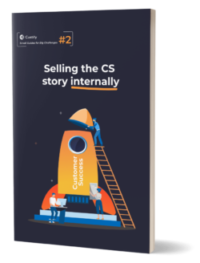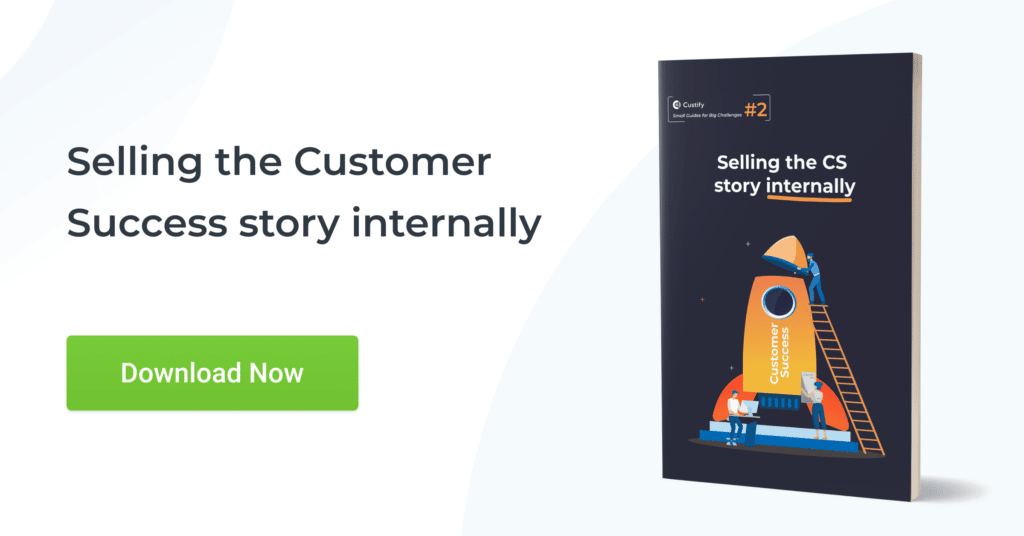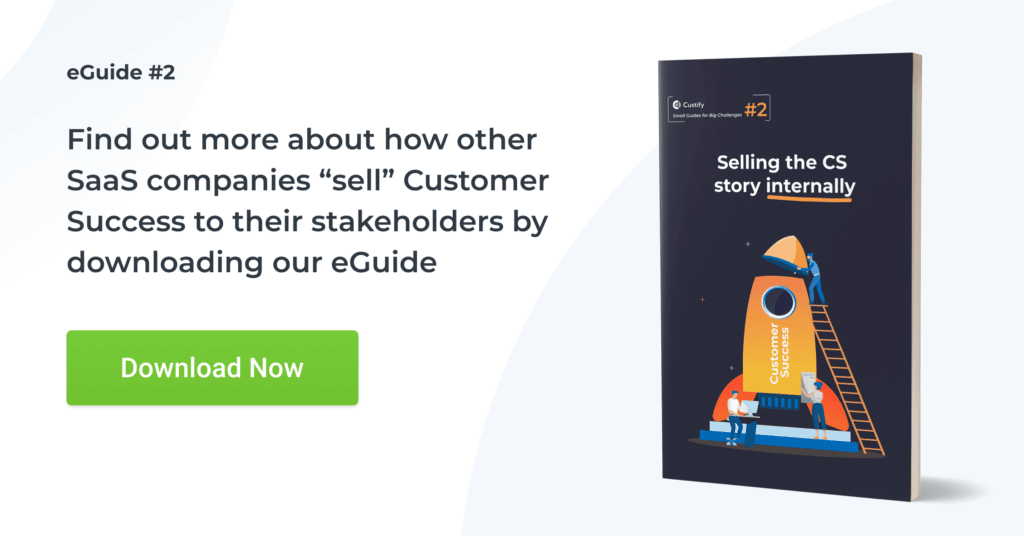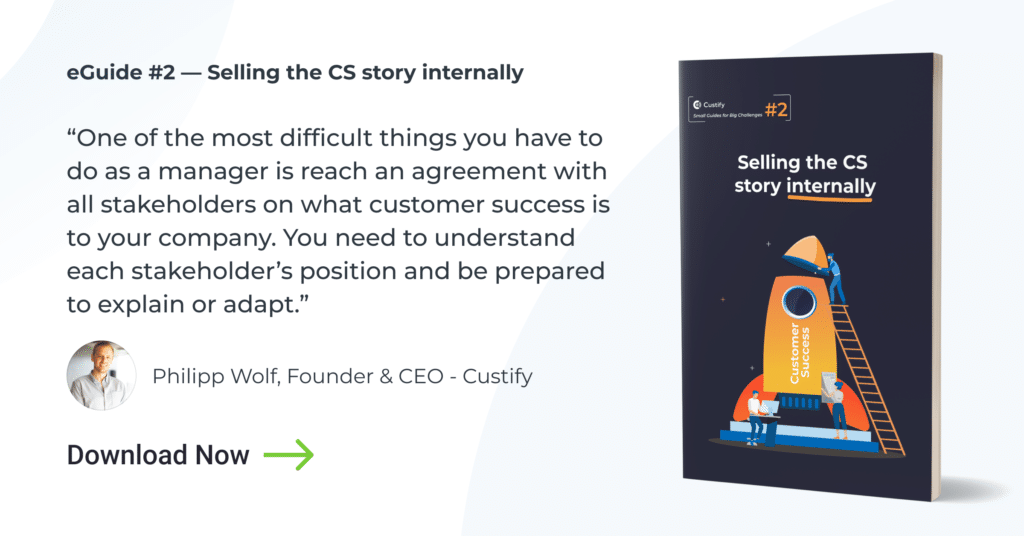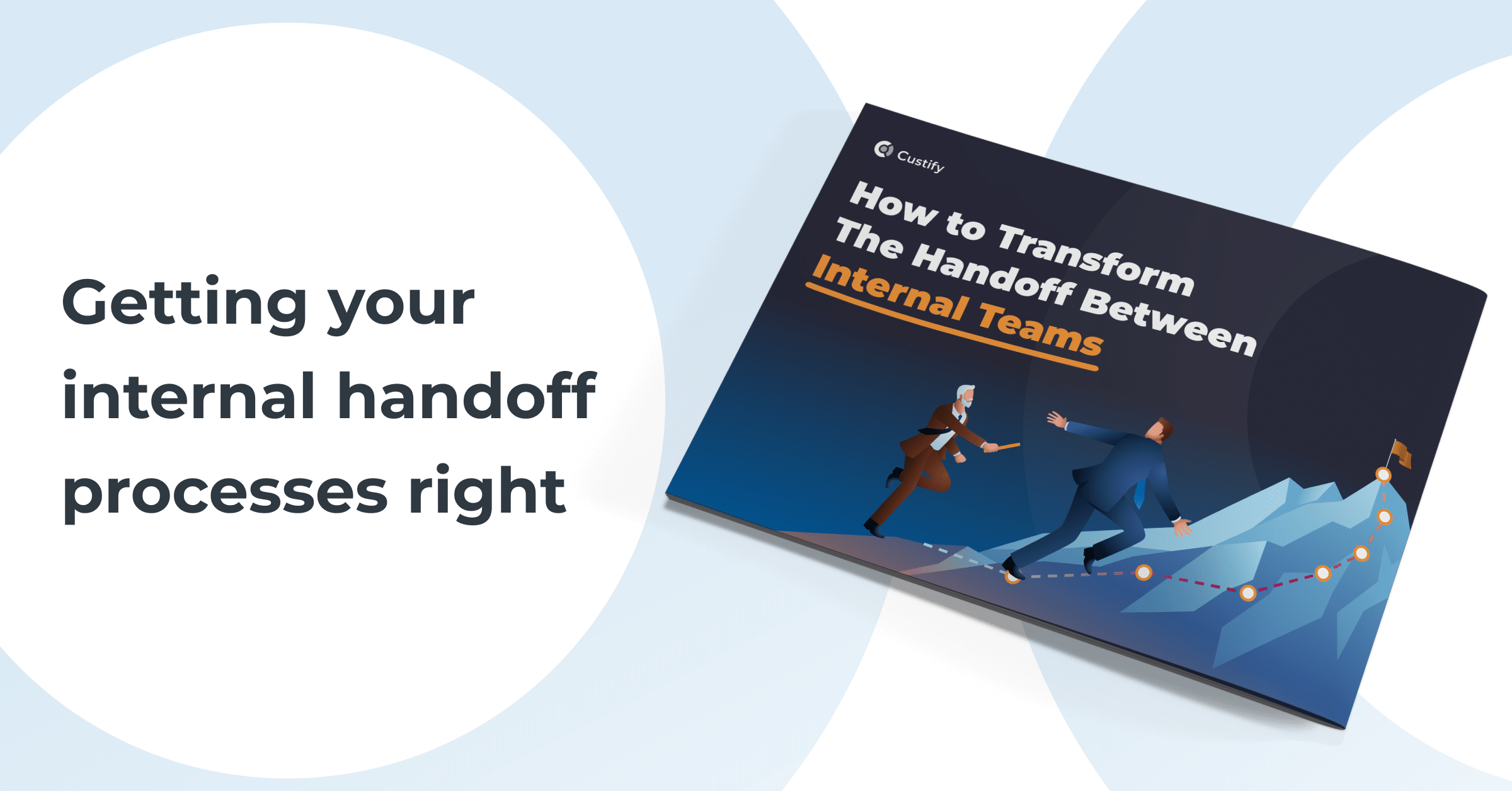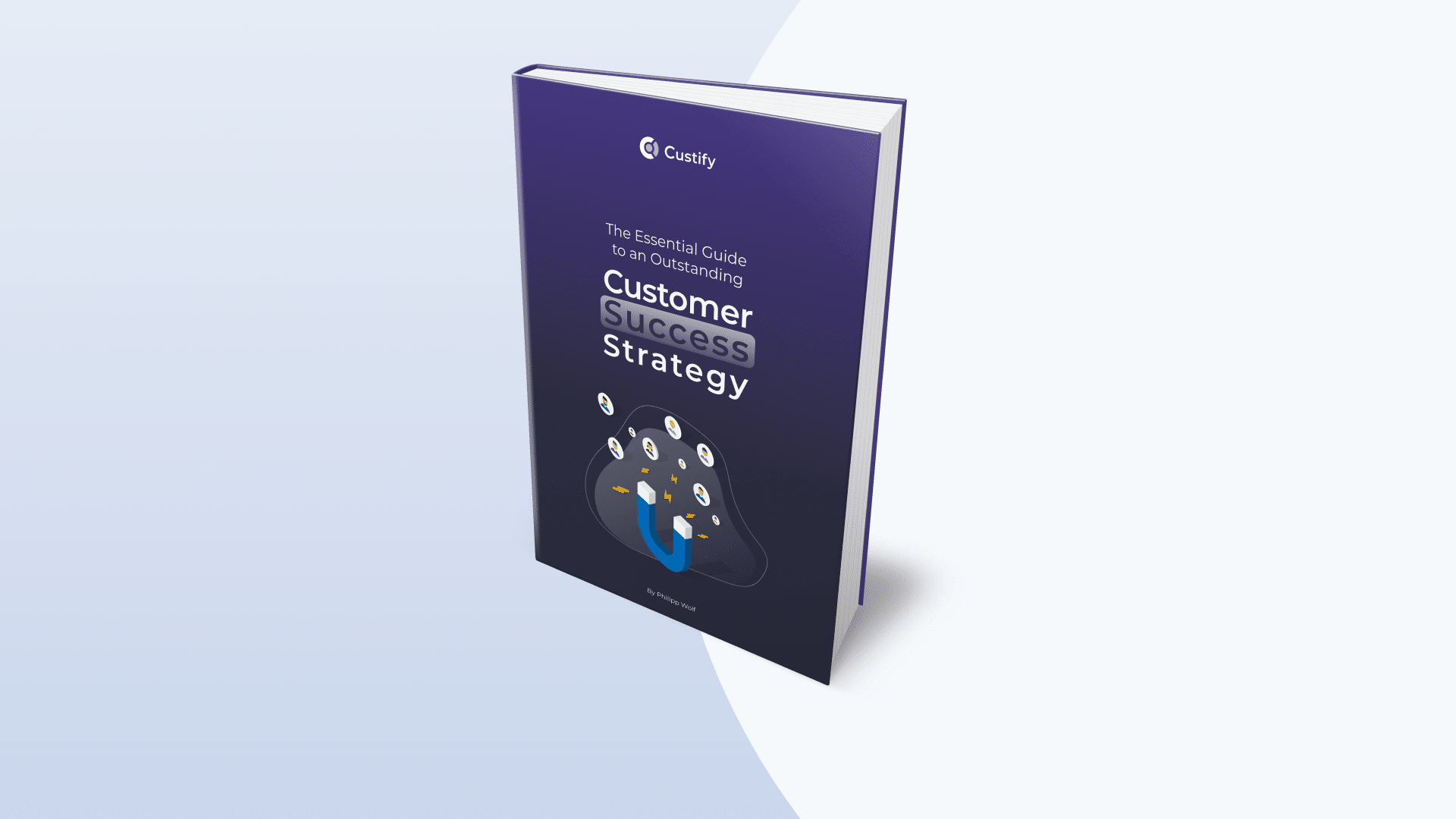Introduction
“One of the most difficult things you have to do as a manager is reaching an agreement with all stakeholders on what customer success is to your company. You need to understand each stakeholder’s position and be prepared to explain or adapt. In theory, companies understand the importance of CS, but in practice, they need a strong data-backed argument in order to allocate proper funds for tools and resources” “One of the most difficult things you have to do as a manager is reaching an agreement with all stakeholders on what customer success is to your company. You need to understand each stakeholder’s position and be prepared to explain or adapt. In theory, companies understand the importance of CS, but in practice, they need a strong data-backed argument in order to allocate proper funds for tools and resources” – Philipp Wolf, Founder & CEO of Custify
This is why we’ve put together this e-guide to help customer success leaders advocate their initiatives internally and get stakeholder buy-in, whether from the CEO, CFO, CPO, COO, or other stakeholders.
Here are the most common objections CS leaders generally face and how to address them:
1. Why do we need a Customer Success team if we already have Account Managers and Customer Experience & Support teams?
Because customer success is not account management, nor is it customer support. Each of these business functions has different objectives and requires a different skill set.
Account managers are not focused on making their assigned customers successful; their main focus is growing these accounts and, thus, the revenue they bring. Simply put, account managers are focused on upsells and cross-sells.
In terms of skills, account managers need to understand the product they’re selling inside and out to be able to propose product solutions and encourage upsells and cross-sells. Meanwhile, customer success managers need to understand their customers and how they can help them succeed.
If we talk about customer success vs. support, the main difference between them is in their nature — customer success is proactive, while customer support is reactive. The customer success manager reaches out with a solution before the client even realizes they have a problem, while a customer success rep helps customers solve a problem when they reach out.
Also, keep in mind that even if you don’t have a customer success department, customers still need support, so costs even out between the two. Launching a customer success program increases internal costs, but decreases support costs per customer in the long run. CS ensures your customers won’t leave after a few months of constant support requests, and it will also actively decrease the support workload, making everything more cost-effective.

2. Why should we hire if we can automate & organize?
In reality, customer success is not something that’s easy to automate if you want to do it right. For example, do you know how many CSMs you need and how many accounts each of them can handle?
There’s this myth going around that each CSM should handle approximately $2M in ARR. However, this claim doesn’t take into account the following factors that influence the optimal ARR / CSM ratio:
- Your Average Revenue Per Account (ARPA) — what if you target SMBs, and your entire revenue doesn’t even get near the $2M mark?
- The complexity of your product — the more complex your product is, the more hand-holding your customers will need, and the fewer accounts a single CSM will be able to handle in a proactive way
- The maturity of your in-app onboarding — onboarding is the most critical stage of the customer journey that has a significant direct impact on adoption, retention, and churn. If your onboarding is not optimized (for each persona, customer segment, etc.), CSMs will need to spend more time with each client
- Your organization’s lifecycle stage — for most companies, the onboarding stage is the most resource-intensive stage of the customer journey. So, as your company matures and reaches the next stages, customers in the onboarding stage of the customer journey will represent a smaller and smaller percentage of your overall customer base
- The seniority of your CSM team — senior CSMs are more efficient because they know the processes they should follow and enforce. This allows them to solve customer requests faster thanks to their experience — therefore, a senior CSM can handle more customers than a junior one
- The cost of your CSM — the optimal ARR / CSM ratio should take into account CSM impact vs. CSM cost, and the latter is different depending on where your CSMs are located.
Instead, a better approach would be to start with hiring one dedicated CSM, see how much work they can handle, and then increasingly hire more following the same principle. Automation can help, but keep in mind that a CSM’s main purpose is to drive success through customer interaction and monitoring. If you assign more customers to a CSM than they can handle, that will affect the customer experience and, ultimately, defeat the purpose of having dedicated CSMs in the first place.
“To me, the number of CSMs changes based on a lot of factors:
- How many customers I have
- Average revenue per account
- Total desired revenue coverage
- How in-depth I expect account relationships to be
- What the expected responsibilities of the CSM are
To have moderate relationships with most customers and a strong relationship with a few more strategic customers, I think 10-20 accounts usually make sense for a single CSM. Then, you need to back out how many accounts you may need to cover to hit your target revenue coverage.
Strategic accounts usually have a much lower ratio of 1 CSM to 3 or 5 customers, but the expectation is revenue per customer is at least 3-5x what you might see with your higher ratio customers.
So no magic number per se, but that’s how I would do the math. The last limiting factor, of course, is how much budget you have to hire talent. This can also dramatically impact the number of members you have on your team!” – Jason Morisson, Senior CSM at UiPath
3. Why do we need a dedicated tool for customer success?
When trying to get stakeholder buy-in, the C-suite especially will be interested in knowing why it’s necessary to invest in another, dedicated tool for customer success, and why the current tools can’t do the job. Technology is a necessity for supplementing the work the customer success team does and helping scale operations without adding headcount.
More than that, just like different business functions have different objectives, different tools also serve different purposes. For example, Hubspot is a great tool for marketing and sales proposals, but it’s not great for representing data in graphics or for tracking custom metrics per user account. If you’re interested in how customers use your product, how their onboarding flow is going, and how their activity improves or declines month over month, then you need a dedicated customer success tool.
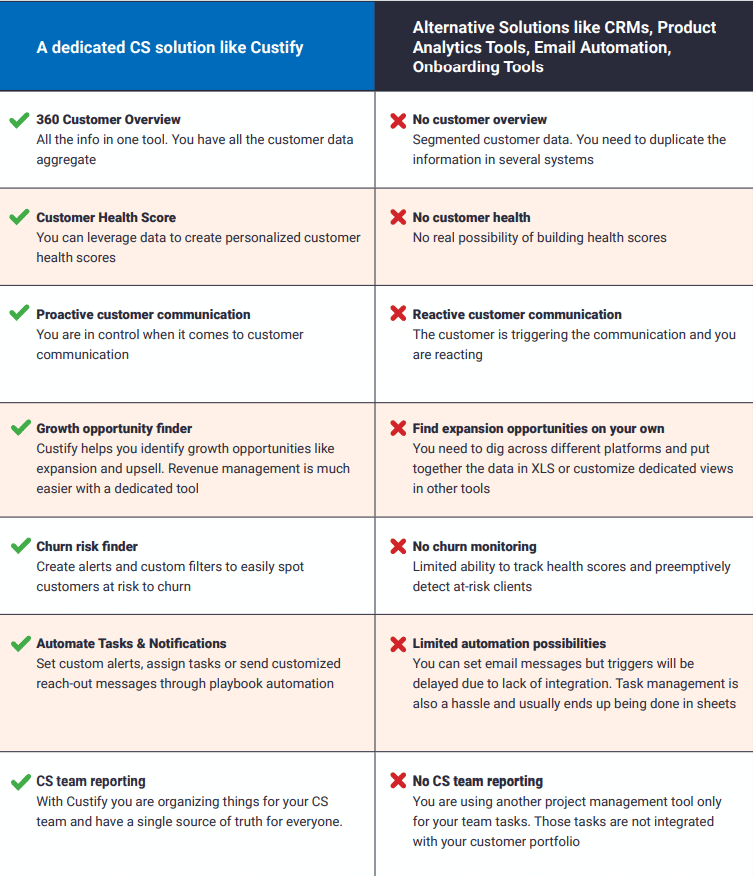
4. What is the CS team’s ROI?
Another aspect stakeholders in the C-suite care about deeply is the ROI, and CS leaders need to provide tangible results if they hope to get their buy-in. But the thing is, quantifying the exact Customer Success ROI value can be quite a mind-boggling task; there’s no single universally proven formula, no one knows the exact ROI of their CSMs, and many organizations struggle with this.
Here’s how industry thought leaders approach this challenge:
- They assess word-of-mouth marketing results;
- They track how interaction with CSMs influences customers’ behavior — for example, how many customers the CSMs save and the revenue that comes from the recovered customers;
- They correlate NPS to LTV (or other business metrics);
- They track metrics that directly affect the customer, such as Average Initial Response Time & Average Resolution Time, while doing regular customer satisfaction surveys.
As you can see, although investing in a customer success department definitely adds value to every SaaS business, the impact of CS is many times intangible. This makes calculating an exact ROI difficult.
On the one hand, that’s because there are factors outside a CSM’s control that impact retention rates on a regular basis, such as:
- Overall global economic situation
- Competitive landscape changes
- Your own product development & improvement.
On the other hand, assessing the exact value and revenue input from customer success programs can prove difficult because:
- As your business becomes more mature, you can see that the net retention rates constantly improve over time, and it’s not just the impact from CS;
- Your business keeps growing over time, and therefore your marketing teams also grow and develop more leads with higher lifetime values & better retention rates;
- As your product develops, you add new features, fix bugs, or eliminate downtimes — all these natural improvements impact the retention curve over time, and you can’t attribute them all to CS exclusively.
At Custify, in order to calculate the actual ROI of customer success, we first try to understand the status quo and measure its impact on the baseline:
- The “baseline” status represents the measured revenue from the client’s account prior to CS actually engaging with those customers
- The measurable impact is the revenue generated by CS through actively engaging with these accounts — making sure they onboard successfully and getting them to expand, renew, or upsell.
Keep in mind that quantifying these 2 variables is not easy since there may be other factors responsible for the visible growth of your customers.
A possible solution to this issue may be looking at customers’ lifecycles to determine the overall Customer Success ROI. That works because, if a customer’s lifetime increases while being under the evaluation and management of CS departments, then their profitability also increases.
Learn more about our proposed solution for calculating Customer Success ROI by downloading our e-guide. Meanwhile, if you’re looking for a quick insight into the ROI of Customer Success, you can also check out our dedicated Customer Success ROI calculator.
